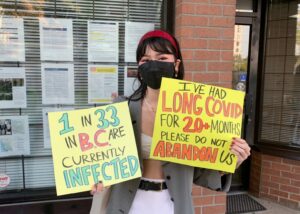By: Izzy Cheung, Staff Writer and Olivia Visser, Copy Editor
Content warning: mentions of gore, war, and torture.
Some argue we should add a content warning to graphic material on social media. Others say those in the west shouldn’t have the right to look away as we are removed from war, compared to those suffering violent attacks in Palestine. However, what happens when graphic material traumatizes viewers? What if seeing this content triggers people with PTSD? Does taking space away from social media mean we don’t care?
Olivia: There are plenty of ways to be an activist on or offline, but social media has become one of the best ways to connect people around the globe. Without it, the general public would have to rely solely on news organizations and word-of-mouth to get their information. For this reason, mediums like Instagram and TikTok can be a great way to share resources — but should merely using social media count as consent to view graphic content? Most platforms have guidelines surrounding graphic media, and will generally blur out these posts unless you intentionally press a button to view them. However, in times of heightened conflict and injustice, there are simply too many posts for even an automated moderation system to account for.
I’ve had more than a few experiences scrolling through Twitter and coming across graphic images or videos of death. This is a long-standing issue, but recent attacks in Gaza have spurred more of these posts. As someone who lives in Canada, it’s easy to say I don’t want to see these images — nobody wants to, but it’s still the reality for the millions of people who live through war and injustice. I understand the desire to document reality, and I can’t reasonably tell people to censor their own suffering. At the same time, I don’t think you need to see visible evidence of cruelty to know it exists and to empathize. There are plenty of people with all kinds of trauma that simply can’t look at images of death, not to mention the fact that content moderators often develop PTSD as a result of frequently viewing such material. Are you less of an activist because you opt to scroll past disturbing content? Not necessarily.
Izzy: I can see why people wouldn’t want to see violent depictions of torture, death, or overwhelming amounts of gore unpromptedly. However, there is a certain level of ignorance that comes with content warnings. Content warnings on social media give you the option to look past whatever might be blurred and completely ignore the issue altogether, which is something I’ll admit I’ve been guilty of. While some of us may be able to empathize with others in certain situations, it’s hard to know the severity of an issue if we just skip over it. This is especially true if we’re not overly knowledgeable about a situation.
Some content creators and journalists have even accused various social media platforms of muting content about Palestine even if all it does is discuss what’s going on. In this context, it feels important to spread what we can to raise awareness about the scale of violence in Palestine. Many journalists who have covered the ongoing attacks in Gaza have been silenced, leaving the duty of dispersing this news to social media. Suppressing this kind of content, even without specific trigger warnings, creates a society that’s ignorant about issues that don’t directly concern us. Being exposed to information that might make us uncomfortable allows us to engage with struggles occurring around the world that we might not initially be aware of. It demands we pay attention.
Olivia: I agree people need to be uncomfortable sometimes — reality is uncomfortable, and we generally need to feel some level of discomfort if we want to meaningfully engage in activism. However, I don’t think people should be expected to view disturbing photos or videos in order to be educated. Graphic content can go beyond mere education and genuinely traumatize people. Many have cautioned against sharing such videos to avoid traumatizing yourself or others. Psychologist Monnica Williams told NPR that footage of violence and death can be highly traumatizing, “especially if you’re part of a stigmatized or minoritized group that’s often dealing with trauma like this.” While there is absolutely an argument to be made for sharing injustices that happen in the world, I also wonder if the loved ones of victims are always comfortable with these videos being shared. I can’t really tell people what they can and cannot rightfully share — especially if they’re the ones in front of or behind the camera — but I do think visually graphic content should come with a warning whenever possible. However, if someone is disturbed by violent footage, that also doesn’t mean they should avoid engaging with troubling issues altogether. There are ways to draw attention to injustice without potentially triggering people. Ultimately, it’s important to stay informed, in whichever way works for you.
Izzy: In an ideal world, I don’t think it should take seeing disturbing content to be able to empathize with others, but unfortunately that often ends up being the case. It’s not fair for the families and loved ones of those who may be the subject of this content to have to witness this over and over again, nor is it fair to any of the victims. Graphic content can only accomplish so much in terms of activism, but doing something about it is up to the person viewing it. Seeing injustice, rather than just hearing about it, could prompt more action from those of us who are on the other side of the world. Visual manifestations may demonstrate the severity of attacks in Palestine to those not directly involved, in turn commanding us to take action. Opening eyes to the hospital situations in Gaza will rightfully force these narratives into our online conversations.
While advocating on social media can be helpful to introduce us to issues we aren’t familiar with, we should also seek to make lasting change through other opportunities. Keeping difficult conversations going within your own social circles can potentially educate those around you more than an Instagram post could. Attending protests or walkouts can help raise awareness. While it’s true that we have the privilege of resting from home, taking breaks from exposure to difficult content is important so you have the energy to take action. Online activism is important for generating conversations — but we need to do more than that to keep them going.














